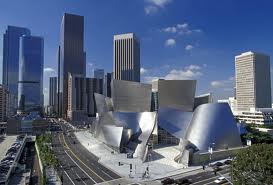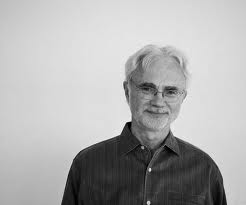Four New Angeleno Composers – Performed at Disney Hall
 On Tuesday December 3, 2013 the Los Angeles Philharmonic New Music Group presented LA Now: Four New Angeleno Composers, the latest in the Green Umbrella series of new music concerts. Curated by no less an eminence than John Adams, works by Sean Friar, Julia Holter, Andrew McIntosh and Andrew Norman were performed for a mostly young and enthusiastic audience that filled three quarters of the Walt Disney Concert Hall.
On Tuesday December 3, 2013 the Los Angeles Philharmonic New Music Group presented LA Now: Four New Angeleno Composers, the latest in the Green Umbrella series of new music concerts. Curated by no less an eminence than John Adams, works by Sean Friar, Julia Holter, Andrew McIntosh and Andrew Norman were performed for a mostly young and enthusiastic audience that filled three quarters of the Walt Disney Concert Hall.
In the pre-concert panel discussion we learned that over 100 compositions were considered during the selection process and that Mr. Adams sought music that “speaks of Los Angeles” and displayed a sense of provincialism – in the best sense of that word. The composers were each asked to identify what makes new music in Los Angeles unique, and comments such as “freedom to try things”, “dispersed”, “experimental” and “entrepreneurial” were heard. Noting that the musical forces specified in these four pieces were generally on the small side, moderator Chad Smith – LA Phil Vice President of Artistic Planning – asked “Is the orchestra still relevant? Do you write music for a full orchestra?” To which Julia Holter quipped “Only if you need to write such a piece to graduate…” and this provoked a knowing laugh from the many music students present. But the mood was upbeat – there is a lively new music scene in and around downtown Los Angeles, and Disney Hall is situated at the center of it.
The first piece on the program was Little Green Pop by Sean Friar and the instrumentation consisted of piano, trombone, soprano and tenor saxes, electric guitar and percussion. This seemingly small assemblage produced an unexpectedly large sound, beginning with a run of light staccato tones that evolved into a series of louder chords. The quick tempo and syncopated rhythms were guided nicely by the precise and clear conducting of John Adams. The tones seem to pop out of the instruments, the harmonies and textures changing with almost every beat and this created a kind of pointillist construction of sound that was very effective. At other times, separate lines would pile together combining into a wonderful mash. Cymbals added an element of majesty and motion that eventually culminated in a great blast from the horns. Sustained and quiet tones followed, producing a moment of calm reflection before building again in tempo and volume and leading to a rousing finish. This was a work whose architecture delivered impressive constructions of sound from relatively small musical forces and Little Green Pop was received with enthusiastic applause.
Memory Drew Her Portrait by Julia Holter followed and this was a world premiere commissioned by the Los Angeles Philharmonic. This piece featured a more conventionally arrayed chamber orchestra consisting of flute, oboe, clarinet, bassoon, horn, trombone and keyboard, with a string section consisting of four violins, two violas, two cellos and a double bass – all presided over by John Adams conducting. The composer sang the solo vocals whose text was based on an extended original poem that forms the focus of this work. The opening mournful horn solo immediately sets the tone for this piece – a story of lovers parted. Ms. Holter was mentioned as being in the same league with Joni Mitchell and Laura Nyro in the pre-concert discussion and the comparison is apt, less because of the purity of her voice but more in the way that the music, text and voice are joined seamlessly to propel the serious emotional trajectory of the piece. The voice is an equal partner here and the smooth passages in the orchestra serve to effectively reinforce the mood of the text. The accompaniment is direct and accessible, yet adds the requisite atmosphere to the poignant lyrics. The combination of powerful poetry, insightful orchestration and the strong emotional component in the vocals fully connected with the audience, who responded with sustained applause.
After the intermission, Etude IV by Andrew McIntosh was performed by James Sullivan and Brian Walsh playing clarinet with Mark Menzies on violin. This is a quiet piece consisting of a series of scales that repeat in various combinations of intervals and pitches. This piece employs just intonation – a type of microtonal music that employs tuning based on the natural harmonic ratios of pitches and not the conventional 12 equal divisions of the octave. Etude IV is one of a series exercises that Andrew wrote to help the players practice in these different tunings. In the program notes Andrew states that “…present in the pieces is my fascination with some of the more orderly facets of the natural world so the forms and harmonic constructs of the pieces are often very geometric or symmetrical in some way… In Etude IV (my personal favorite) the symmetry is reflected in time as each phrase goes out of phase with itself…” The sound of this occasionally had an Asian feel and often produced interesting harmonies and timbres as the instruments ascended each of the scale patterns. The hearing was good – even in the higher elevations of Disney Hall where I was sitting – but some of the subtleties of the harmonic interplay were undoubtedly lost given the sizable space; this music is most often performed in a much more intimate setting. On the whole, it was a generally restful and almost meditative experience, a fine contrast to much of what was heard in the first part of the concert. Etude IV is very representative of the work being done with alternate tunings in the Los Angeles new music scene and the structure of this piece also owes something to process, another historical West Coast influence.
The final piece of the concert was Try by Andrew Norman and for this John Adams resumed his role as conductor of a group identical to that of Memory Drew Her Portrait, save the addition of a trumpet. But the sound could not have been more different – Try is a furious, high energy stringendo-on-steroids wall of sound that jumped off the stage and seemed barely contained by even the spacious Disney Hall. Swirling, always moving ,yet able to turn on a dime, this piece most reminded me of the old Warner Brothers cartoon music – and this, of course, is a compliment. The playing was precise and deadly accurate despite the frenetic pace and the ensemble managed to keep a keen edge on the river of sound that was sent flowing from the stage. Percussion and brass added an almost explosive element to the ever-building torrent and just when you were sure it couldn’t get any wilder – it went quiet. Piano and flute traded soft phrases and eventually the piano alone was left to repeat a theme of just a few notes. A slight acceleration in the final phrase, then some quiet quiet chords… and an audience sitting in stunned silence. This piece was an emotional roller coaster ride and received a loud ovation in response. It is hard to believe that the music of Andrew Norman won’t find its way to a movie screen or a TV series sometime soon.
 LA Now: New Angeleno Composers was an exciting event much appreciated by the sizable audience. Credit goes to John Adams for what must have been no small effort to curate and produce such a concert. Congratulations to all the composers whose work was performed, it was a night to remember.
LA Now: New Angeleno Composers was an exciting event much appreciated by the sizable audience. Credit goes to John Adams for what must have been no small effort to curate and produce such a concert. Congratulations to all the composers whose work was performed, it was a night to remember.
Concert notes, composer links and more information about this performance are here.